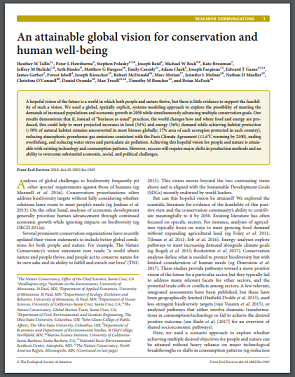
A hopeful vision of the future is a world in which both people and nature thrive, but there is little evidence to support the feasibility of such a vision. We used a global, spatially explicit, systems modeling approach to explore the possibility of meeting the demands of increased populations and economic growth in 2050 while simultaneously advancing multiple conservation goals. Our results demonstrate that if, instead of “business as usual” practices, the world changes how and where food and energy are produced, this could help to meet projected increases in food (54%) and energy (56%) demand while achieving habitat protection (>50% of natural habitat remains unconverted in most biomes globally; 17% area of each ecoregion protected in each country), reducing atmospheric greenhouse-gas emissions consistent with the Paris Climate Agreement (≤1.6°C warming by 2100), ending overfishing, and reducing water stress and particulate air pollution. Achieving this hopeful vision for people and nature is attainable with existing technology and consumption patterns. However, success will require major shifts in production methods and an ability to overcome substantial economic, social, and political challenges.












